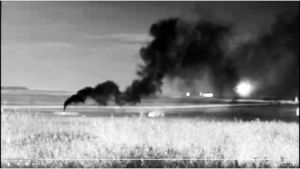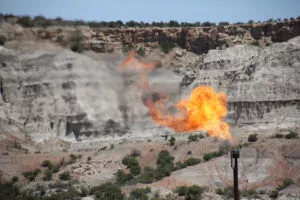Both oil and gas well sites and processing and transmission infrastructure emit pollutants into the atmosphere from different equipment and activities. To learn about the various sources of these the particular contaminants, visit the Oil and Gas Pollution page.
Many gases and chemicals associated with oil and natural gas development may show up in emissions. For example, air sampling by Earthworks near compression and processing facilities in Pennsylvania detected more than 70 distinct chemicals.
This page provides general descriptions of the most common air pollutants associated with oil and gas production. These include:
Methane (CH4) is the primary component of natural gas and closely linked to climate change. (Natural gas typically also contains valuable hydrocarbons such as ethane, propane, butane, and pentanes, which are separated out through processing.) Over a 20-year timeframe, methane is 86 times more potent a greenhouse gas than carbon dioxide. When first produced, natural gas is odorless; the chemical methyl mercaptan is added later to odorize gas so leaks can be detected.
Carbon Dioxide (CO2) is the primary greenhouse gas implicated in climate change, as well as the most persistent in the atmosphere. CO2 is released through combustion of fossil fuels, including flaring, production, processing, and any activities involving vehicles and engines. CO2 reduces oxygen flow for breathing, and can also cause hypertension, headaches, dizziness, nerve damage, and skin and eye irritation.
Volatile Organic Compounds (VOCs) are a class of many carbon-containing substances that easily turn into gases or vapors and become airborne (volatilize). VOCs can combine with nitrogen oxides and sunlight to form ground-level ozone, which can cause respiratory ailments such as asthma and decreased lung function.
Chief among the VOCs associated with oil and natural gas development are benzene, toluene, ethylbenzene, and xylene. These compounds, known as the BTEX chemicals, are associated with central nervous system, neurological, and reproductive impacts. Benzene is also a known carcinogen and ethylbenzene and xylene can cause respiratory problems.
Formaldehyde is another VOC of growing concern in oil and gas areas. Primarily viewed as a by-product of construction and household products, formaldehyde also results from industrial combustion processes. It is a known carcinogen and associated with respiratory problems and lung damage.
Hydrogen sulfide (H2S) occurs naturally in some oil and gas formations, particularly in the western United States. H2S may be released when gas is vented, when there is incomplete combustion of flared gas, or via fugitive emissions from equipment. It is often separated out during gas processing.
H2S a toxic gas with a characteristic rotten egg odor. It can cause eye, skin, and respiratory problems at low concentrations and is lethal if inhaled in high concentrations. A federal hazard alert warns oil and gas workers about inhaling H2S vapors at production sites.
The five criteria pollutants associated with oil and gas that are regulated by the US Environmental Protection Agency under the Clean Air Act include:
- Ozone (O3) is created when volatile organic compounds and nitrogen oxides combine with sunlight. When found at ground-level, ozone is also referred to as smog, which can cause or aggravate respiratory ailments such as asthma and emphysema.
An analysis of impacts on health found that nationally, ozone created by the oil and gas industry causes 750,000 summertime asthma attacks in children and 2,600 asthma and respiratory emergency room visits.
- Particulate Matter (PM) is composed of small particles that are suspended in the air and settle to the ground slowly. Particulate matter is measured as PM10, which are small particles ten micrometers or less in diameter, or as PM2.5, for even smaller fine particles. The most common sources of PM from oil and gas operations are dust or soil entering the air during site or facility construction, traffic, and diesel exhaust from vehicles and equipment. PM can also be emitted during venting and flaring operations.
Depending on the size of particles and their chemical composition, inhalation of PM can cause respiratory and cardiovascular problems, as well as premature death. When suspended in air, PM decreases visibility and general air quality.
- Carbon Monoxide (CO) is a colorless, odorless, flammable gas produced by the incomplete combustion of carbon-based fuels (i.e., oil, natural gas, coal, and wood). CO is primarily emitted by the oil and gas industry during flaring and the operation of machinery and equipment. The health impacts of CO include inhibiting the blood’s ability to carry oxygen, as well as headaches, dizziness, and nausea. In some cases, inhalation can result in unconsciousness and death.
- Nitrogen Oxides (NOx)is a group of gases formed during the combustion of fossil fuels, which causes a chemical reaction between nitrogen (which occurs naturally in the atmosphere) and oxygen. In oil and gas production, NOx are formed during flaring operations and when fuel is burned to provide power to machinery such as compressor engines and other heavy equipment. NOx combines with VOCs in the presence of sunlight to form ground-level ozone. The health impacts of NOx include eye, nose, and throat irritation, respiratory problems, heart conditions, and lung damage.
- Sulfur Dioxide (SO2) is a colorless gas with a very strong odor. It is formed through the combustion of fossil fuels that contain sulfur (including oil, natural gas, and coal). SO2 may be emitted during flaring of natural gas, or when fossil fuels are burned to provide power to pumpjack or compressor engines or other equipment and vehicles at oil and gas sites. Sour gas processing plants also emit sulfur dioxide. Along with NOx, SO2 is a principal contributor to acid rain.
The health impacts of SO2 include eye, nose, and throat irritation, respiratory problems, nausea, headaches, and dizziness. SO2 also reacts with other chemicals to form particulate matter, which can damage lungs and cause respiratory and cardiovascular problems and premature death.
For More Information
- Sources of Oil and Gas Air Pollution
- Oil and Gas Air Pollutants Summary Chart
- Chemicals in Natural Gas Operations, research and information from the Endocrine Disruption Exchange
- Tox Town information portal, National Institutes of Health
- Toxic Substances information portal, Agency for Toxic Substances & Disease Registry, US Centers for Disease Control
- Fact sheets on Hazardous Substances, State of New Jersey Department of Health
- Think Again: Earthworks’ fact sheet on air pollution from oil and gas facilities
- Permitted to Pollute, Earthworks’ report on air pollution issues in the PA oil & gas industry
- Oil and Gas Pollution


